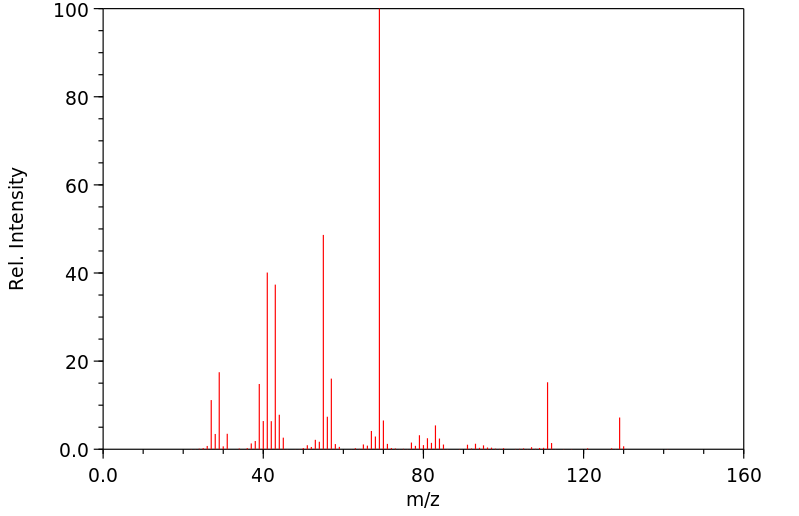1-十一碳炔-4-醇 | 22127-86-2
中文名称
1-十一碳炔-4-醇
中文别名
——
英文名称
undec-1-yn-4-ol
英文别名
1-undecyn-4-ol
CAS
22127-86-2
化学式
C11H20O
mdl
——
分子量
168.279
InChiKey
IBEKWLNDNQDLQS-UHFFFAOYSA-N
BEILSTEIN
——
EINECS
——
-
物化性质
-
计算性质
-
ADMET
-
安全信息
-
SDS
-
制备方法与用途
-
上下游信息
-
文献信息
-
表征谱图
-
同类化合物
-
相关功能分类
-
相关结构分类
物化性质
-
沸点:122-125 °C(Press: 17 Torr)
-
密度:0.877±0.06 g/cm3(Predicted)
-
保留指数:1107
计算性质
-
辛醇/水分配系数(LogP):3.6
-
重原子数:12
-
可旋转键数:7
-
环数:0.0
-
sp3杂化的碳原子比例:0.82
-
拓扑面积:20.2
-
氢给体数:1
-
氢受体数:1
安全信息
-
海关编码:2905290000
SDS
上下游信息
-
下游产品
中文名称 英文名称 CAS号 化学式 分子量 —— 1-undecyne-4-ol methyl ether 142088-53-7 C12H22O 182.306
反应信息
-
作为反应物:参考文献:名称:On the use of 3-bromopropyne as a reagent for the introduction of the pyruvate moiety摘要:在金属锌存在下,3-溴丙炔与醛反应生成同三碳炔醇,随后通过乙酰化反应与N-溴代琥珀酰亚胺和少量乙酸银反应,转化为相应的溴代同三碳炔乙酸盐。这些衍生物再经四氧化锇和叔丁基过氧化氢氧化,生成γ-乙酰氧基-α-酮酯,从而实现了一个便捷的四步序列来引入丙酮酸部分。DOI:10.1039/c39910001289
-
作为产物:描述:参考文献:名称:金催化的叶立德氧羰基氧化同炔丙基醚。摘要:合成有用的α,β-不饱和羰基化合物是在温和的反应条件下,通过金催化的炔丙基醚的氧化重排而获得的。拟议中的金类胡萝卜素和叶立德是重要的中间体。DOI:10.1021/ol302238t
文献信息
-
Barbier-type allylation of carbonyl compounds and imines with metallic cadmium作者:Bir Sain、Dipak Prajapati、Jagir S SandhuDOI:10.1016/s0040-4039(00)61288-1日期:1992.8Cadmium mediated allylation of a variety of carbonyl compounds and imines in a Cd/Bu4NBr/THF system afforded excellent yields of the corresponding homoallylic alcohols and amines under very mild reaction conditions.
-
Cadmium metal-mediated allylation of carbonyl compounds作者:Shuki Araki、Hirokazu Ito、Yasuo BatsuganDOI:10.1016/0022-328x(88)80263-8日期:1988.6Metallic cadmium prompted Barbier-type coupling of carbonyl compounds and allylic halides. The reaction was regio-selective homoallylic alcohols coupled at the γ-position of allylic halides, α,β-Unsaturated carbonyl compounds underwent only 1,2-addition.
-
Revisiting the Addition of in-situ Nucleophiles to Allenic Ketones: An Entry Towards Synthesis of Benzodioxins作者:Sushree Ranjan Sahoo、Debayan SarkarDOI:10.1002/ejoc.202000076日期:2020.3.22A revisit towards regioselective addition of in situ generated negative nucleophiles to allenic ketones in the presence of a base. A direct ring annulation towards the benzodioxin skeleton synthesis has been developed. In the process, the obtained E‐vinyl kenones were readily transformed into sulfones and 2,5‐disubstituted oxazole.
-
Synthesis of (4E)-7-methoxytetradec-4-enoic acid: a novel fatty acid from lyngbya majuscula作者:Craig B. Fryhle、Paul G. Williard、Rybak Carol M.DOI:10.1016/s0040-4039(00)74202-x日期:1992.4The synthesis of (4E)-7-methoxytetradec-4-enoic acid is described. This novel fatty acid is found in the blue-green algae . and is incorporated as the amide in several nitrogeneous metabolites, including the fish antifeedant compound malyngamide A.
-
Efficient Synthesis of γ-Lactones via Gold-Catalyzed Tandem Cycloisomerization/Oxidation作者:Chao Shu、Meng-Qi Liu、Yu-Zhe Sun、Long-Wu YeDOI:10.1021/ol302323a日期:2012.9.21A novel Au-catalyzed tandem cycloisomerization/oxidation of homopropargyl alcohols was developed. Various γ-lactones can be accessed readily by utilizing this strategy. Notably, the mechanism of this reaction is distinctively different from the related Ru-catalyzed reactions where the ruthenium vinylidene intermediate was proposed.
表征谱图
-
氢谱1HNMR
-
质谱MS
-
碳谱13CNMR
-
红外IR
-
拉曼Raman
-
峰位数据
-
峰位匹配
-
表征信息
同类化合物
(±)17,18-二HETE
(±)-辛酰肉碱氯化物
(Z)-5-辛烯甲酯
(Z)-4-辛烯酸
(R)-甲羟戊酸锂盐
(R)-普鲁前列素,游离酸
(R,R)-半乳糖苷
(E)-4-庚烯酸
(E)-4-壬烯酸
(E)-4-十一烯酸
(9Z,12E)-十八烷二烯酸甲酯
(6E)-8-甲基--6-壬烯酸甲基酯-d3
(3R,6S)-rel-8-[2-(3-呋喃基)-1,3-二氧戊环-2-基]-3-羟基-2,6-二甲基-4-辛酮
龙胆二糖
黑曲霉二糖
黄质霉素
麦芽酮糖一水合物
麦芽糖醇
麦芽糖酸
麦芽糖基蔗糖
麦芽糖一水合物
麦芽糖
鳄梨油酸乙酯
鲸蜡醇蓖麻油酸酯
鲸蜡醇油酸酯
鲸蜡硬脂醇硬脂酸酯
鲸蜡烯酸脂
鲸蜡基花生醇
鲫鱼酸
鲁比前列素
鲁比前列素
高级烷基C16-18-醇
高甲羟戊酸
高效氯氰菊酯
高-gamma-亚油酸
马来酸烯丙酯
马来酸氢异丙酯
马来酸氢异丁酯
马来酸氢丙酯
马来酸氢1-[2-(2-羟基乙氧基)乙基]酯
马来酸单乙酯
马来酸单丁酯
马来酸二辛酯
马来酸二癸酯
马来酸二甲酯
马来酸二烯丙酯
马来酸二正丙酯
马来酸二戊基酯
马来酸二异壬酯
马来酸二异丙酯







